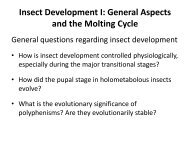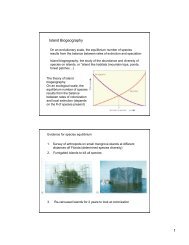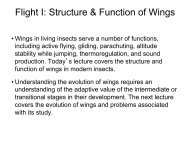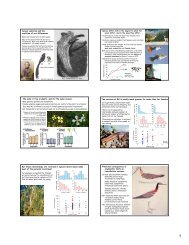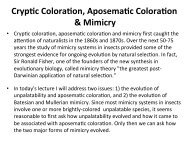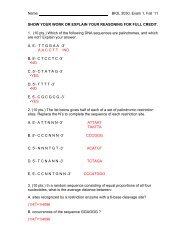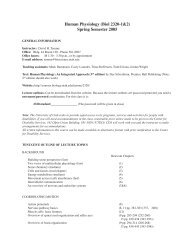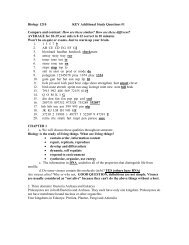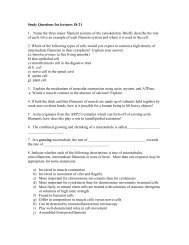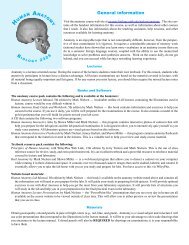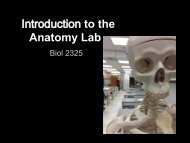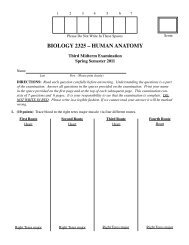Insect Orders II: Orthopteroids - Biology Courses Server
Insect Orders II: Orthopteroids - Biology Courses Server
Insect Orders II: Orthopteroids - Biology Courses Server
You also want an ePaper? Increase the reach of your titles
YUMPU automatically turns print PDFs into web optimized ePapers that Google loves.
<strong>Insect</strong> <strong>Orders</strong> <strong>II</strong>: Polyneoptera (cont’d)<br />
• The Polyneoptera consists of 11 extant orders. All<br />
orders except the Plecoptera have terrestrial<br />
wingless immature stages that resemble the adult<br />
stage (paurometabolous development). The<br />
Plecoptera have aquatic nymphs that do not<br />
resemble the adult stage (hemimetabolous<br />
development).<br />
• Sister group relationships in the Polyneoptera are<br />
still unresolved in many respects, largely do to the<br />
lack of a sufficient number of derived characters<br />
shared among the members (synapomorphies).<br />
• The order Orthoptera is by far the most diverse<br />
order in the Polyneoptera, followed by the<br />
Dictyopteran orders. At least two orders, the<br />
Grylloblattodea and the Mantophasmatodea appear<br />
to relicit groups, widely distributed but of low<br />
diversity.<br />
• The Zoraptera is a particularly difficult order to place<br />
phylogenetically, but it now appears to the sister<br />
group of the Embiidina.
Phasmatodea (Stick and leaf insects)<br />
• Classification. More than 3000 species segregated<br />
into 4 families. Higher classification is unclear and<br />
subject to debate, as is the sister group relationships<br />
of walking sticks.<br />
• Structure. Elongate body, some times very large (>50<br />
cm in one species from Borneo). Antennae are short<br />
to very long and slender. Wings much reduced or<br />
absent in many species. Body segments in some<br />
species elaborated with spines, flanges and other<br />
processes that aid in crypsis or in direct defense<br />
against predators. Possession of anterior dorsolateral<br />
defensive gland on the prothorax. Eggs have an<br />
operculum (lid) and are elaborately sculptured.<br />
• Natural history. Most species are slow moving<br />
herbivores commonly found on vegetation. Walking<br />
sticks defend themselves from predators through<br />
crypsis or release of defensive chemicals. Many<br />
species orient their bodies parallel to their perch and<br />
slowly sway back and forth if disturbed. This<br />
movement presumably mimics vegetation caught in<br />
the wind. Walking sticks can regenerate limbs, which<br />
is uncommon in insects. Males mate with females by<br />
mounting on their back and rotating their abdomen<br />
through 180 o during copulation. Many species are<br />
parthenogenetic. Eggs are scatter from high<br />
vegetation and apparently mimic plant seeds. Eggs of<br />
some species are picked up by ants and tended in ant<br />
nests until they hatch.
Wing loss and recovery in stick insects<br />
In 2003 Michael Whiting of BYU<br />
and colleagues published a<br />
paper that argued that wings in<br />
walking sticks were lost and<br />
recovered several times<br />
independently.
Orthoptera (Crickets, katydids, wetas,<br />
grasshoppers and kin)<br />
• Classification. Over 20,000 species divided into two<br />
suborders: the Ensifera (true crickets, Mormon crickets,<br />
long-horned crickets, Jerusalam crickets and katydids), and<br />
the Caelifera (short-horned grasshoppers, lubber<br />
grasshoppers, slant-faced grasshoppers, and pygmy mole<br />
crickets). The Ensifera consists of 10,000 species in 10<br />
families and first appeared in the late Permian (250 mya).<br />
The Caelifera consists of about 11,000 species in 20<br />
families and first appeared in the Triassic (240 mya)<br />
• Structure. A famous orthopteran apomorphy is the<br />
possession of saltatorial hind legs. Ensifera have long<br />
flagellate antennae, Caelifera have reduced antennae. All<br />
species have chewing mouthparts. Ovipositor is long in the<br />
Ensifera and short in the Caelifera. Some species with<br />
highly modified body form are obligate nest associates of<br />
ants. Many species have specialized structures for<br />
acoustical communication.<br />
• Natural history. Most species are phytophagous, but<br />
some species of Ensifera (Tettigoniidae) are predaceous.<br />
Caelifera are active during daylight and Ensifera are<br />
usually active at night. Orthopterans defend themselves<br />
from predators through crypsis, spines on their legs and<br />
bodies, or toxic chemicals and aposomatic coloration.<br />
Some species of Caelifera are deadly. A number of species<br />
are migratory over long distances and during outbreaks can<br />
cause devastating agricultural damage (e.g., the desert<br />
locust, the migratory locust and the Mormon cricket).
Acoustic communication in the Orthoptera<br />
• Orthopterans are the most vocal of all insect<br />
orders, with calling behavior playing a major<br />
role in the biology and evolution of the<br />
order. Acoustic signals are used in<br />
courtship, mating and male-male<br />
competition for mates. Songs are often<br />
species-specific.<br />
• In the Ensifera acoustical signals are<br />
produced by rubbing a specialized area of<br />
the right forewing across a corresponding<br />
area of the left forewing. The rasping sound<br />
created by the file and scrapper on the<br />
wings is amplified by specialized<br />
membranes on the wings called “mirrors”.<br />
Sound reception occurs through forewardfacing<br />
tympanal membranes located on the<br />
tibae of the forelegs.<br />
• In the Caelifera acoustical signals are<br />
produced by scrapping the hind legs against<br />
stiff edges of the forewings. Sound reception<br />
is accomplished by tympanal membranes<br />
on the abdomen.<br />
• Males in one relicit family of Caelifera<br />
(Cylindrachetids) produces their song by<br />
rubbing their mandibles together. Another<br />
goup of Caelifera make cone-shaped<br />
“amphitheaters” at the opening of their<br />
subterranean tunnels to amplify their calls.<br />
Cylindrachetid<br />
File on cricket<br />
forewing<br />
Foretibial tympanum<br />
of cricket<br />
Drum-like mirror on<br />
fossil cricket forewing
• The Dictyoptera comprise the last 3 orders<br />
in the Orthopteroid (Polyneopteran)<br />
complex: the Blattaria (cockroaches),<br />
Isoptera (termites) and Mantodea<br />
(mantises).<br />
• Relationships among these 3 orders is<br />
much debated and much of the debate is<br />
caused by the common assumption that<br />
all three orders are monophyletic.<br />
• Modern understanding of the relationships<br />
among these three groups is derived from<br />
three character system, the<br />
proventriculus, male genitalia and the<br />
vestigial ovipositor. The deposition of the<br />
eggs in the form of an ootheca is also a<br />
groundplan feature of the Dictyoptera.<br />
• Recent evidence indicates that the<br />
Blattaria is the sister group of the<br />
Mantodae and that the Isoptera are<br />
embedded in the Blattaria, making the<br />
Blattaria paraphyletic as currently defined.<br />
Dictyoptera<br />
Proventriculus<br />
Oothecae
Blattaria (Roaches)<br />
• Classification. 4000 described species in 460<br />
genera. Family-level classification is unsettled, but<br />
centers around 6. Phylogenetic relationships<br />
among these families is also debated. The position<br />
of the genus Cryptocercus is of particular interest<br />
in its relationship to termites.<br />
• Structure. Body in all species is dorso-ventrally<br />
flatten with a shield-like pronotum that covers the<br />
head. Forewings form overlapping tegmina. Eggs<br />
are enclosed in a capsule called an ootheca.<br />
• Natural history. Most species are nocturnal. The<br />
small minority that are active during daylight are<br />
brightly colored. Most species are terrestrial, with a<br />
few species primarily arboreal. Some species are<br />
obligate nest associates of ants. Most species are<br />
omnivorous. Species in the genus Cryptocercus<br />
feed on wood with the aid of symbiotic gut protists.<br />
These symbionts are lost during each molting<br />
cycle and individuals must be re-inoculated.<br />
Species of Cryptocercus live in kin groups that<br />
facilitate the re-inoculation process. Behavior<br />
superficially similar to termites.
Isoptera (Termites)<br />
• Classification. 2900 species divided into 7 families, with over<br />
80% of the species belonging to the “higher” termite<br />
family,Termitidae. The Isoptera is the only major insect order<br />
without an extinct family. Termites arose in the Late Jurassic<br />
(150 mya) or Early Cretaceous (140 mya), relatively late<br />
compared to other polyneopteran orders.<br />
• Structure. Adult termites are polymorphic in body form and<br />
function. These different body forms are called castes. Three<br />
different adult castes exist in termite colonies: 1) winged<br />
primary reproductives, 2) wingless soldiers, and 3) wingless<br />
workers. The soldier caste can be distinguished from the<br />
worker caste by its highly modified head. A fourth caste, the<br />
supplementary reproductives, is sometimes present and is<br />
distinguished from the primary reproductive caste by the<br />
absence of functional wings. Structure and function of the<br />
soldier caste is highly variable among species. Two broad<br />
categories of soldiers exist, those with well developed<br />
mandibles (mandibulate soldiers) and those with reduced<br />
mandibles and a highly modified frontalis (nasute soldiers).<br />
• Natural history. All termite species are eusocial, meaning that<br />
colony members come from two or more generations and that<br />
there is reproductive division of labor among individuals.<br />
Soldiers are behaviorally specialized as nest defenders.<br />
Workers perform most of the day-to-day tasks, including nest<br />
maintenance and foraging. Reproductive castes are egg-laying<br />
machines, who abdomens can become grotesquely enlarged<br />
(physogastric) as it fills with eggs. All termite species live in<br />
nests, some of which can be very elaborate. Termite species<br />
are phytophagous or fungivorous and rely on specialized<br />
symbiotic protists to aid in the digestion of cellulose. Termites<br />
are host to many arthropods that are obligately or facultatively<br />
dependent on termite nests for food and shelter. These<br />
organisms are called termitophiles.<br />
Termite castes Soldier heads
Evolution of Termites<br />
• Recent phylogenetic evidence indicate that the sister group<br />
of the termites is the wood-eating roach Cryptocercus.<br />
• Kin groups of wood roaches consisting of a pair of parents<br />
and about 20 offspring inhabit galleries in a log and they<br />
remain together for at least 3 years. The nymph superficially<br />
resembles termites (small, pale and blind) and take<br />
approximately 6 years to mature.<br />
• Nymphs feed on liquids exuded from the anus of adults for<br />
their first year (proctodeal trophallaxis), which allows them to<br />
acquire mutualistic protists that are required for the digestion<br />
of wood. Nymphs must reacquire these protists after each<br />
molt.<br />
• Cryptocercus shares with two families of lower termites<br />
several genera of distinctive protists. Earlier experiments<br />
have shown that protists extracted from the hindgut of<br />
Cryptocercus can be successfully transferred into the<br />
sterilized hindgut of termites.<br />
• Wood roaches and especially termites harbor a remarkable<br />
diversity of protists in their hindgut, including bacteria,<br />
methane-producing archaebacteria, spirochetes, numerous<br />
protists in a variety of families, and a very basal lineage of<br />
eurkaryotes, the Parabasalea.<br />
• Unlike wood roaches, termites have a huge ecological<br />
impact on their environment. Termites are estimated to<br />
produce 2-5% of global methane (a greenhouse gas). They<br />
are also instrumental in soil mineralization and humification.<br />
In Africa they consume up to 20% of the available plant<br />
biomass.<br />
Trichonympha is a flagellate protozoan that lives in<br />
the hindgut of Cryptocercus and lower termites.
Mantodea (Mantises)<br />
• Classification. 2300 species divided 434 into genera and 8<br />
families. Only one family, the Mantidae, in found in the US.<br />
• Structure. Most distinctive features are the elongated<br />
prothorax and forelegs highly modified into raptorial<br />
appendages used for catching prey. Eyes are large and<br />
bulging with a large frontal field and fovea, giving mantises<br />
excellent binocular vision. Head is freely movable and used<br />
to track and focus on moving prey. Head is hypognathous,<br />
but can be moved into the prognathous position when<br />
attacking and eating prey. More derived groups of mantises<br />
have a unique cyclopean “ear” located on the meta-thorax<br />
between the sternites and just anterior to the hind coxae.<br />
This ear is tuned to the ultrasound frequencies of<br />
insectivorous bats.<br />
• Natural history. Mantises are highly predaceous insects.<br />
They are excellent sit-and-wait predators usually found<br />
perched on vegetation. Many species employed elaborate<br />
cryptic coloration to facilitate camouflage from both<br />
predators and prey, sometimes termed aggressive<br />
mimicry. Some of the larger species are able to catch and<br />
eat small lizards and frogs. Males copulate with females by<br />
mounting on their backs (unique in the Dictyoptera), which<br />
is thought to be an adaptation to avoid being eaten by the<br />
females. Males can execute copulatory movements for up<br />
to 20 hr after decapitation, which suggests that<br />
consumption by their mates is not uncommon. In threequarters<br />
of the species whose mating has been observed,<br />
over 50% of the natural prey items of females were males.
<strong>Insect</strong> <strong>Orders</strong> <strong>II</strong>: Polyneoptera (cont’d)<br />
• The Polyneoptera consists of 11 extant orders. All<br />
orders except the Plecoptera have terrestrial<br />
wingless immature stages that resemble the adult<br />
stage (paurometabolous development). The<br />
Plecoptera have aquatic nymphs that do not<br />
resemble the adult stage (hemimetabolous<br />
development).<br />
• Sister group relationships in the Polyneoptera are<br />
still unresolved in many respects, largely do to the<br />
lack of a sufficient number of derived characters<br />
shared among the members (synapomorphies).<br />
• The order Orthoptera is by far the most diverse<br />
order in the Polyneoptera, followed by the<br />
Dictyopteran orders. At least two orders, the<br />
Grylloblattodea and the Mantophasmatodea appear<br />
to relicit groups, widely distributed but of low<br />
diversity.<br />
• The Zoraptera is a particularly difficult order to place<br />
phylogenetically, but it now appears to the sister<br />
group of the Embiidina.




